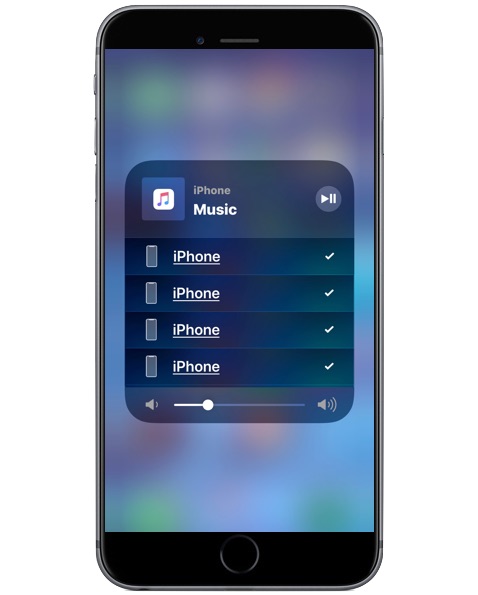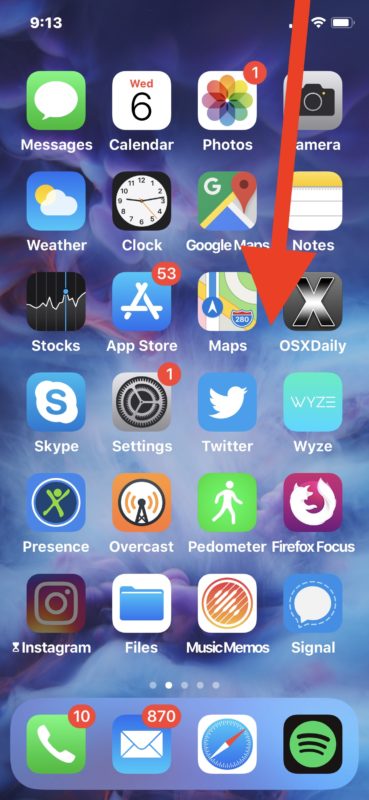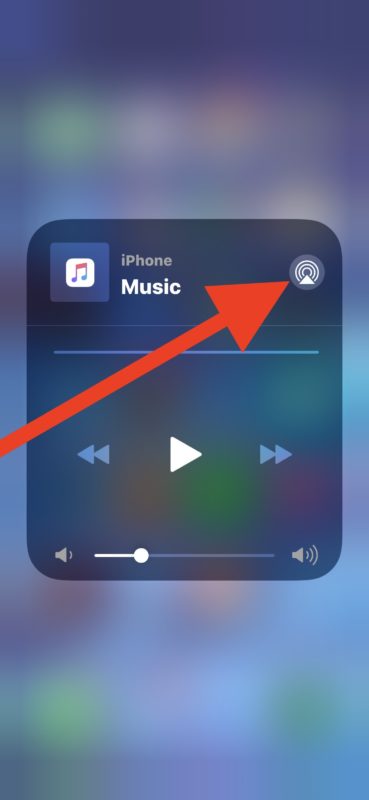How to Access AirPlay Audio in iOS 16, 15, 14, 13, 12 for iPhone and iPad

Wondering how to access AirPlay audio controls in iOS 16, iOS 15, iOS 14, iOS 13, iOS 12, and iOS 11 on an iPhone or iPad? You might not be alone, as accessing the AirPlay controls for audio streaming is tucked away behind another panel in the iOS Control Center, making it very easy to overlook.
If you’re looking for the AirPlay audio streaming controls in Control Center for iOS 16 on iPhone or iPad, we’ll show you how to find them.
How to Access AirPlay Audio Settings on iPhone or iPad to Stream to AirPlay Device
Note that any AirPlay receiver or speaker must be on the same wi-fi network as the iPhone or iPad, this is necessary so the devices can find one another and stream audio.
- Start playing music from your audio library, Spotify, or another audio service
- Access Control Center on the iPhone or iPad, from modern iPhone and iPad devices that means swiping down from the top-right corner of the screen to access Control Center
- Locate the Music control panel and now tap and hold on that (or firm press if you have 3D Touch) to expand it
- Now tap the AirPlay button, it looks like a pyramid with concentric circle waves flying out of it
- Select an AirPlay audio output source from the AirPlay audio device list that is visible (tapping multiple AirPlay output options will play to all of them)




This is where you’ll find audio output sources like AirPods, HomePods, AirPlay speakers, Apple TV, and other AirPlay compatible audio output sources.
Once a selection is chosen, the audio output should now stream wirelessly from the iPhone to the AirPlay speaker. You can select multiple devices here to stream AirPlay audio to multiple speakers or AirPlay receivers.
Why the AirPlay audio option is tucked behind the Music Control Panel isn’t entirely clear, but it can feel hidden to many users who are unfamiliar with long taps and 3D Touches to possibly reveal additional options in iOS. How it is currently with iOS 16, iOS 15, iOS 14, iOS 13, iOS 12, and iOS 11 was not always the case however and so the interface might change again, as earlier versions of iOS Control Center had a more obvious dedicated AirPlay button in earlier iOS versions that were not tucked behind the Music control panel.
AirPlay Speaker Not Showing Up in iOS Control Center?
Depending on what the AirPlay Audio output device, and perhaps what version of iOS you have installed on the iPhone or iPad, you might immediately see the AirPlay speaker available, or you might not. It’s possible to encounter an apparently buggy experience and find the AirPlay speaker never shows up at all in Control Center – nonetheless that doesn’t necessarily mean you can’t use the speaker.
For example in my testing I can successfully output AirPlay audio from an iPhone X to some AirPlay speakers, but they often don’t show up in the AirPlay interface of Control Center of iOS. A way to consistently replicate this quirky experience was to visit a persons home with a Sonos One speaker system setup to use with their unique users iOS device, where my iPhone is able to successfully stream audio output to the Sonos speaker despite the Sonos Speaker never actually showing up in the AirPlay interface of iOS Control Center. Instead, the iPhone is able to stream sound to the Sonos speaker through third party apps like the Spotify app (and again, this is not the iPhone that is setup to use the Sonos so this is not going through the Sonos app), where Spotify finds the speaker in the Spotify device list, despite AirPlay not. Whether or not this is intentional, actually a bug, or a feature with iOS, AirPlay, Sonos, some quirk of this particular configuration, a failure of myself and my own usage, or something else is not clear. Nonetheless it’s not unusual for an iPhone or iPad owner to visit another location with a Sonos or other AirPlay speaker, and a similar situation may be experienced if so.
Here you can see the AirPlay Control Center settings do not find the Sonos Speaker at all, yet despite that the iPhone is streaming audio to the Sonos speaker over AirPlay to the Sonos speaker titled ‘Family Room’:

Thus if you are attempting to use AirPlay audio streaming for something like a Sonos speaker, try using an app like Spotify to select the Sonos speaker system from as the audio output, and in that situation you can skip the iOS Control Center approach to AirPlay entirely. This is a bit odd but it could be a bug that exists, but it’s worth mentioning since this configuration is fairly common. Of course if your iPhone or iPad is setup directly to use the Sonos, then using the Sonos app is the solution instead.
If you have any particular experiences using AirPlay audio and streaming to an AirPlay device from an iPhone or iPad, share with us in the comments below!


Instructions here state to “Access Control Center on the iPhone or iPad, from modern iPhone and iPad devices that means swiping down from the top-right corner of the screen to access Control Center”
This does not work on my iPhone SE running iOS 12.1.4 which is the most up to date version.
To access Control Center, swipe UP from the bottom.
Airplay is a joke anyway, everyone I know who has tried it agrees.
I see. You have an old iPhone but you need a new iPhone. I regret to inform you that your iPhone SE is 3 years old, you’re using an old iPhone and so you don’t have all the new features of new modern iPhone, like innovative swipe down gesture from top-right.
Mr no way, the only solution to your problem is for you to spend $1250 + tax/VAT on the iPhone XS Max 256GB, and I recommend a leather case for it and maybe some AirPods and iPad Pro too. Spend thousands on new Apple kit, then you will have the swipe down gesture.
It just works, for shareholders!!!
Is it possible to change the order of the AirPlay speakers?
The one I use the most is the second last so I always have to scroll.
The list is alphabetical – I don’t think you can change that. What you need to do is change the name of the AirPlay speakers so that they come further up in the list. Check the instructions for your AirPlay speakers – it should be possible to change their AirPlay name.
I did NOT know about this! THANK YOU so much for your handy tips and tricks!
It’s also confusing when you merely want to change a phone call’s output to the built-in iPhone speaker. It used to be you merely press the speaker button while on a phone call.
Now, the speaker button in the phone app shows every available Airplay device!
There’s a way to make the iphone’s speaker to be the default, but that too is ridiculously hidden. It’s in the Preferences panel under the General/ Accessibility menu and listed as Call Audio Routing.
Go figure that one.
If it needs an explanation to even find the setting maybe it’s too complicated?
Long press hard press soft press short press. Who came up with this? Not a UX team?
I can never get AirPlay to work reliably myself in new iOS versions, much like you mention here the receiver usually doesn’t show up in the Control Center, and there are no other places to find the AirPlay settings so I just give up. It doesn’t just work for me.
I really don’t understand the logic of hiding features behind hidden gestures and motions and presses and extended taps. It is not user friendly, it is a guessing game. The guessing game approach to user interface design started with iOS 7 and has stuck around far too long. It’s past time to make interfaces obvious and intuitive again.
There’s a few things you can try, if AirPlay devices aren’t showing up in the list:
1.) Keep the list open for at least a minute. Sometimes devices can take a long time to show up (I don’t know why).
2.) Toggle your WiFi off and on again, then bring up the list again and follow advise of 1.)
3.) If there are any AppleTV devices on the network and you are trying to AirPlay to a different device, AirPlay to the AppleTV first, then bring up the AirPlay device list again and follow advise of 1.)
4.) This one is fairly niche and only applies if there are multiple WiFi access points on the network and at least one of them is an Apple AirPort device, but you are currently connected via a non-Apple device. (For example: on my network, the main router is a non-Apple device, but its WiFi signal doesn’t cover the whole house, so I also have an Apple AirPort Express.)
If this situation applies to you and there’s an AirPlay device not showing in the list, try connecting the WiFi to the Apple AirPort device and bringing up the list again. If the AirPlay device now shows up, connect to it. You should now be able to switch the WiFi connection back to the original connection (if necessary e.g. for signal strength reasons) and the AirPlay will continue to work (with possibly a brief drop-out whilst the WiFi switches over).